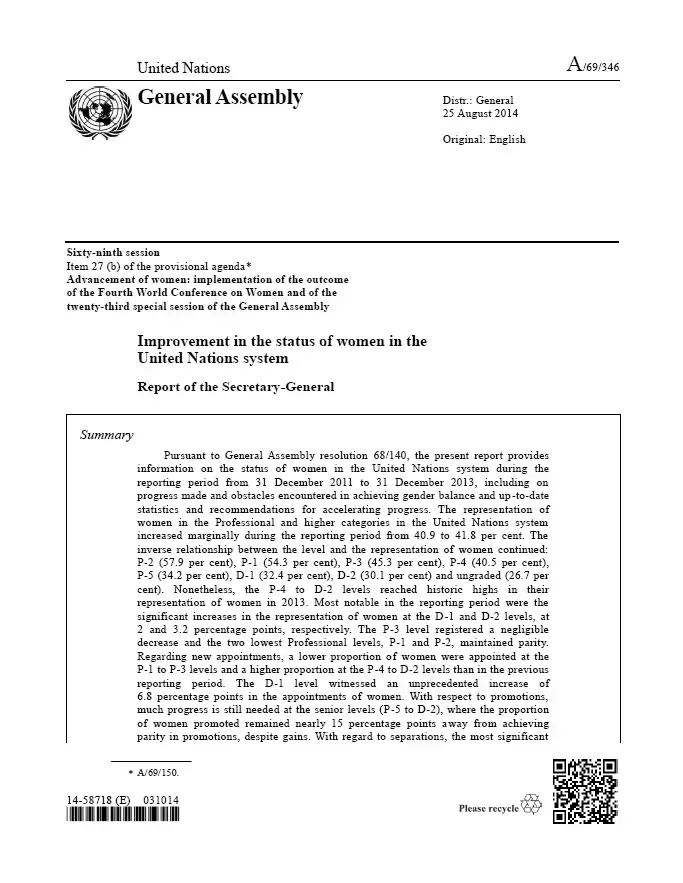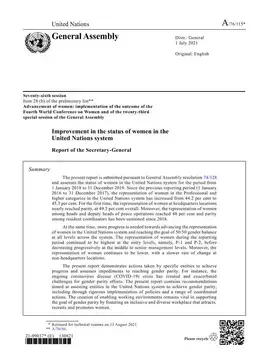
Improvement in the status of women in the United Nations system: Report of the Secretary-General (2014)
Pursuant to General Assembly resolution 68/140, this report (A/69/346) provides information on the status of women in the United Nations system during the reporting period from 31 December 2011 to 31 December 2013, including on progress made and obstacles encountered in achieving gender balance and up-to-date statistics and recommendations for accelerating progress.
The representation of women in the Professional and higher categories in the United Nations system increased marginally during the reporting period from 40.9 to 41.8 per cent. The inverse relationship between the level and the representation of women continued: P-2 (57.9 per cent), P-1 (54.3 per cent), P-3 (45.3 per cent), P-4 (40.5 per cent),P-5 (34.2 per cent), D-1 (32.4 per cent), D-2 (30.1 per cent) and ungraded (26.7 per cent). Nonetheless, the P-4 to D-2 levels reached historic highs in their representation of women in 2013. Most notable in the reporting period were the significant increases in the representation of women at the D-1 and D-2 levels, at
2 and 3.2 percentage points, respectively. The P-3 level registered a negligible decrease and the two lowest Professional levels, P-1 and P-2, maintained parity.
Regarding new appointments, a lower proportion of women were appointed at the P-1 to P-3 levels and a higher proportion at the P-4 to D-2 levels than in the previous reporting period. The D-1 level witnessed an unprecedented increase of 6.8 percentage points in the appointments of women. With respect to promotions, much progress is still needed at the senior levels (P-5 to D-2), where the proportion of women promoted remained nearly 15 percentage points away from achieving parity in promotions, despite gains. With regard to separations, the most significant gender disparity was in the higher separation of women in non-headquarters locations compared with headquarters.
The Secretariat, the largest entity of the United Nations system, distinguished itself during the current reporting period by attaining its highest representation of women to date at the P-2 to D-1 levels: P-2 (55.8 per cent), P-3 (43.4 per cent), P-4 (39.2 per cent), P-5 (31.7 per cent) and D-1 (30.2 per cent). However, the most senior levels continued to register the lowest representation of women: D-2 (26.9 per cent) and ungraded (24.6 per cent). Notably, the representation of women in 2013 at the D-2 level approximates to that of a decade ago (26.8 per cent).
The continuing challenge for the United Nations system, including the Secretariat, is to reverse the inverse relationship between seniority and the representation of women, which points to the need to target each level. In that respect, 50 per cent of the entities surveyed by the United Nations Entity for Gender Equality and the Empowerment of Women (UN-Women) on impediments to achieving gender balance cited a “lack of special measures for appointments and promotions” among their top three choices.
Recommendations to address those challenges include: the need for more intensive sponsorship by senior leaders; more rigorous promulgation and implementation of existing policies, including special measures for women and flexible working arrangements; enhanced monitoring and accountability; career development for female staff members, accompanied by targeted outreach; and harmonization and unification of gender-related policies, as part of the development and implementation of the United Nations System-wide Action Plan for Gender Equality and the Empowerment of Women, led by UN-Women. Approved by the United Nations Chief Executives Board in 2012, it is the first unified gender accountability framework of the United Nations system and establishes 15 standards, 3 of which pertain to the status of women and their equal representation in the United Nations system, to be achieved by 2017.


